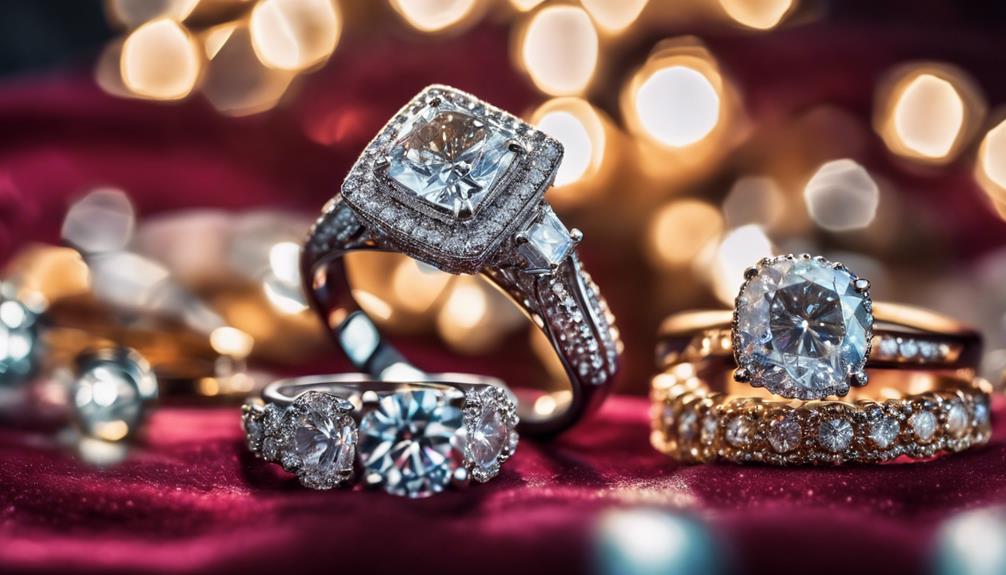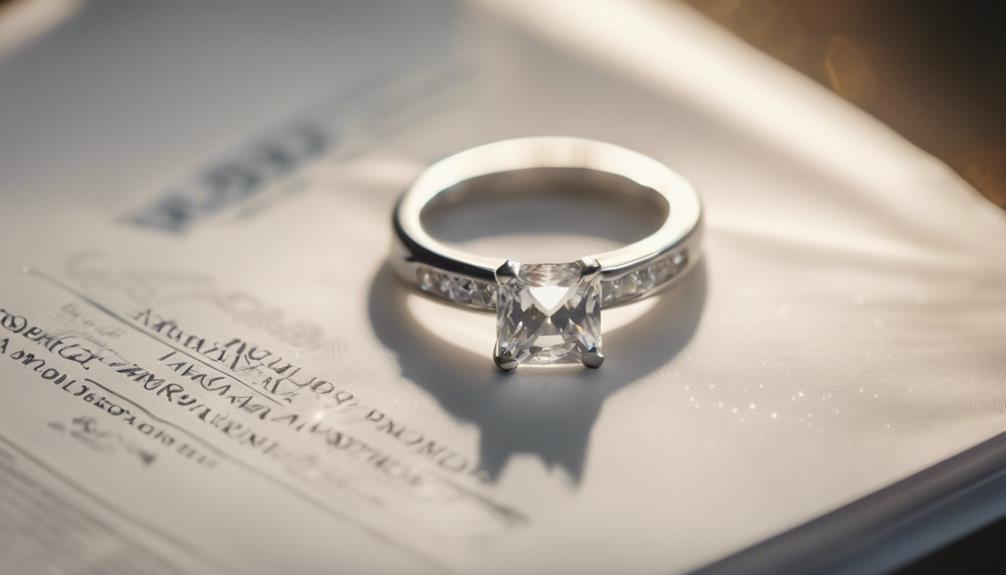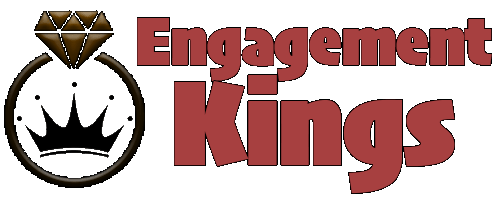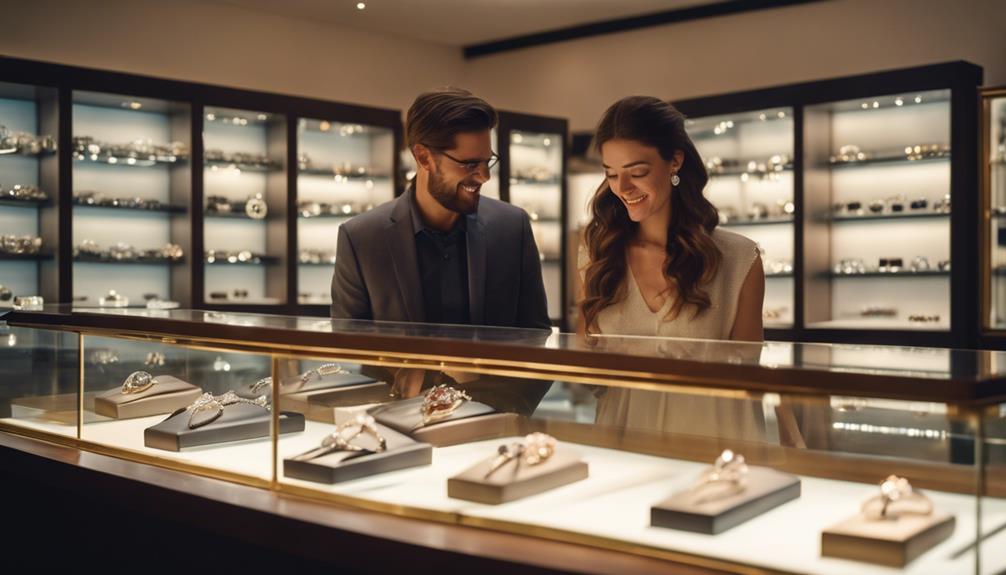Before you shop for an engagement ring, understand the 4Cs: cut, color, clarity, and carat weight, as these determine quality and value. Choose a shape and setting that match your partner’s style and lifestyle. Set a budget that feels right for your finances, considering average costs and potential extra expenses like insurance. Plan ahead, especially for custom designs, to avoid stress and last-minute rushes. Confirm your diamond is certified and look into insurance options for added protection. There’s much more to explore that will help you find the perfect ring.
Understanding the 4Cs

When shopping for an engagement ring, you’ll need to understand the 4Cs of diamonds: cut, color, clarity, and carat weight. Each of these characteristics plays a vital role in determining the diamond’s overall quality and value.
First, consider the cut of the diamond. The cut directly affects how well the diamond reflects light, contributing to its brilliance and sparkle. A well-cut diamond will appear more dazzling compared to one with a poor cut.
Next, focus on the diamond’s color. Diamonds are graded on a scale from D (colorless) to Z (light yellow or brown). The less color a diamond has, the rarer and more valuable it is.
Clarity is another important factor. It assesses the presence of internal inclusions and external blemishes. Diamonds with fewer imperfections are higher in quality and, consequently, more valuable.
Lastly, carat weight measures the size of the diamond. Larger diamonds are rarer and typically more expensive. The price often increases considerably at each full carat weight, so even small differences can impact the cost.
Understanding the 4Cs will help you make an informed decision and find the perfect diamond for your engagement ring.
Choosing the Right Shape and Setting
Selecting the right shape and setting for an engagement ring is vital in creating a piece that perfectly matches your partner’s style and lifestyle. The shape of the center stone greatly influences the ring’s overall aesthetic. Popular shapes like round, princess, oval, and emerald each offer a distinct look, so think about which one aligns best with your partner’s preferences.
The setting plays an important role in showcasing the center stone. Whether you choose a solitaire, halo, or three-stone setting, each style can enhance the stone’s visual impact by making it appear larger or more brilliant. Don’t forget about custom settings if you want something uniquely personal, but keep in mind they may take extra time and budget.
Durability is a key factor, especially if your partner leads an active lifestyle. Some settings provide better protection for the stone, reducing the risk of damage or snagging. Make sure the combination of shape and setting aligns with how the ring will be worn daily.
Setting a Budget

After choosing the right shape and setting, it’s time to set a budget that aligns with your financial comfort and priorities. When engagement ring shopping, it’s essential to establish a budget that fits your circumstances rather than adhering to outdated norms, like spending three months’ salary. The average cost of an engagement ring in the U.S. is roughly $6,000, but your budget should reflect what you’re comfortable spending.
While considering the price tag, think about more than just the upfront cost. Include additional expenses such as insurance and maintenance. These factors can greatly impact how much you should realistically spend on an engagement ring without causing financial strain.
Lab-grown diamonds offer a budget-friendly option, costing around 30-50% less than natural diamonds, allowing you to get a beautiful ring without breaking the bank. In addition, strategically choosing diamond shapes like emerald or oval can create the illusion of a larger stone at a lower cost. Also, buying just below common carat weights can save you nearly 20%, helping you stretch your budget further.
Setting a budget is a personal decision, so focus on what makes sense for your finances and future.
Timing and Custom Designs
Planning ahead is essential when you’re considering custom designs for an engagement ring. Timing plays a vital role, as a custom design can take anywhere from 3 to 6 weeks to complete. You should plan well in advance of your proposal date to guarantee everything runs smoothly.
Many jewelers recommend allowing at least 6 weeks for the entire order process, especially if you want custom engravings or unique features. This timeframe includes consultations, design adjustments, and the actual crafting of the ring. Engaging with your jeweler early on can provide valuable insight into design timelines and help set realistic expectations for when the ring will be ready.
Additionally, keep in mind that seasonal peaks for engagement ring shopping typically occur around holidays and special occasions. Shopping during off-peak times can offer better deals and a wider selection.
Custom designs often require more time for consultation and adjustments, so starting the design process early can help you avoid last-minute stress.
Certification and Insurance

When buying an engagement ring, make sure the diamond comes with a certification from a reputable gemological institution like the GIA to verify its quality and authenticity. The Gemological Institute of America (GIA) provides a detailed report on the diamond’s cut, color, clarity, and carat weight, ensuring you know exactly what you’re purchasing.
Next, consider getting insurance for your ring to protect against loss, theft, or damage. You can add it to your existing homeowners’ insurance or get a specialized jewelry policy. To do this, you’ll need an appraisal from a certified gemologist. This appraisal will establish the ring’s value for coverage purposes, giving you peace of mind.
Don’t forget to review the warranty information provided by the jeweler. A warranty often covers manufacturing defects and may include maintenance services, such as prong tightening and polishing. However, remember that a warranty is different from insurance. While a warranty covers issues like defects, insurance protects you against unfortunate events like loss or theft.
Conclusion
You’ve got the basics down—understanding the 4Cs, picking the right shape and setting, setting a budget, and giving yourself enough time for custom designs.
Now, you’re ready to plunge into the exciting journey of finding the perfect engagement ring.
Remember, this process is about creating a memorable and meaningful experience for both you and your future spouse.
Trust your instincts and enjoy each moment of this special journey.
You’ve got this!



